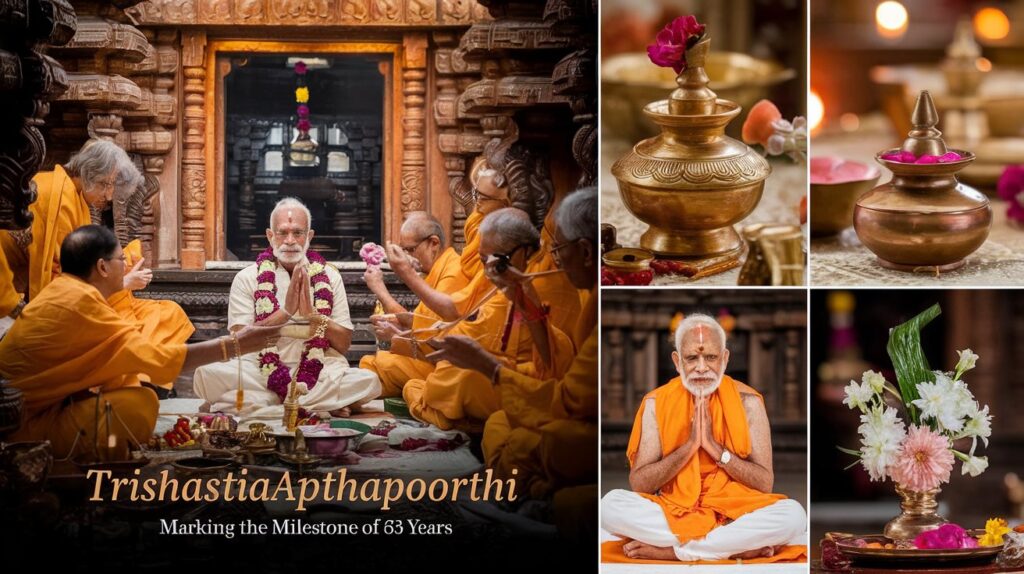Trishastiapthapoorthi Trishashti Aptha Poorthi, a sacred Hindu ceremony, celebrates the milestone of completing 63 years of life. Derived from the Sanskrit term Trishashti meaning sixty-three, this event signifies a significant phase of spiritual and personal growth. In Hinduism, each milestone represents a deeper connection to the divine and an opportunity for reflection on one life journey.
The ceremony is rooted in the belief that age and experience bring spiritual wisdom, making it a crucial moment in the life of a Hindu. It marks the transition from the householder’s duties into a more spiritually-oriented phase, focusing on reflection, devotion, and enlightenment.
The Significance of Trishastiapthapoorthi in Hinduism
Hindu philosophy divides life into four stages, or Ashramas: Brahmacharya (student), Grihastha (householder), Vanaprastha (retirement), and Sannyasa (renunciation). People celebrate the Trishastiapthapoorthi ceremony when an individual turns 63, marking their entry into the Vanaprastha stage, where they shift their focus from worldly affairs to spiritual growth.
Why 63 Years?
- Age and Spiritual Wisdom: At 63, an individual is believed to have lived a full life and gained enough wisdom to transition into a more contemplative phase. This aligns with the Hindu belief in a human being’s theoretical lifespan of 120 years. Therefore, 63 represents the halfway point, marking the completion of a full cycle of sixty-three years.
- Spiritual Preparation: The ceremony prepares the individual for Vanaprastha, where they are expected to step back from daily concerns and devote themselves to spiritual practices.
Rituals and Ceremonies Involved in Trishastiapthapoorthi
The Trishastiapthapoorthi ceremony involves several key rituals that are rich in symbolism and spiritual significance. These ceremonies not only honor the individual but also invite divine blessings for a peaceful and spiritually fulfilling life.
Key Rituals:
- Yamuna Puja:
The ceremony begins with worshipping Yamuna, the sacred river goddess, to purify the mind and body of the individual. - Kalasha Sthapana:
They place sacred pots filled with water to invite divine energy into the ceremony and the individual’s life. - Nandi Puja:
People believe that worshipping Nandi, the bull associated with Lord Shiva, brings strength and divine protection to the individual as they transition to the next phase of life. - Prayers to Deities:
The ceremony includes prayers to a host of deities, including Maha Ganapati, Navagraha (nine planets), and Ayurdevata, which represent prosperity, health, and spiritual guidance. - Ganapati Homam:
The offering of prayers and sacred fire rituals to Ganapati for the removal of obstacles and blessings for a peaceful life ahead.
Symbolism Behind Trishastiapthapoorthi Rituals
Each ritual performed during the Trishastiapthapoorthi carries profound meaning that resonates with the spiritual journey the individual is about to embark on.
Key Symbolism:
- Kalasha Sthapana:
This ritual symbolizes the welcoming of divine energy into the individual’s life. It represents spiritual renewal and the individual’s connection to the divine. - Nandi Puja:
Nandi is a symbol of devotion, strength, and protection. The Nandi Puja signifies that the individual is now ready to receive divine guidance for spiritual growth. - Transition to Vanaprastha:
The ceremony marks the shift from worldly concerns to spiritual aspirations, signifying the individual’s readiness to embrace celibacy and a life dedicated to selfless service.
Resources for Further Reading and Understanding
To deepen your understanding of Trishastiapthapoorthi, there are numerous resources available that explore the spiritual and cultural aspects of Hindu life cycles.
- Books:
- The Four Stages of Life by Swami Vivekananda
- Hindu Rites and Rituals by K.N. Sivan
- Articles and Journals:
Explore scholarly articles on Hindu ceremonies and their symbolism in academic journals like JSTOR or Google Scholar. - Websites:
Websites dedicated to Hinduism, such as Hinduism Today and The Hindu Portal, offer in-depth insights into the significance of milestone ceremonies.
Predictions for the Future of Hindu Milestone Ceremonies
As Hinduism adapts to the modern world, people may celebrate the Trishastiapthapoorthi ceremony in new ways. However, the core spiritual values and rituals will remain a part of the tradition.
Future Trends:
- Globalization of Hindu Milestones:
With Hinduism spreading across the globe, we may see more non-Hindu communities adopting or recognizing such milestones. This could promote intercultural celebrations of Hindu traditions. - Modern Adaptations:
The ceremony may begin to incorporate virtual elements due to technological advancements, allowing families separated by distance to participate in the ritual remotely. - Spiritual Reflection in the Digital Age:
As the world becomes increasingly fast-paced, ceremonies like Trishastiapthapoorthi offer a rare opportunity for individuals to pause, reflect, and reconnect with their spiritual selves.
FAQs
What is the significance of Shashti Poorthi?
Shashti Poorthi marks the completion of sixty years of life, signifying the transition from the householder phase to the spiritual phase of life. It represents a new beginning, a time for spiritual growth and reflection.
What is the puja of Shashti Poorthi?
The puja involves rituals like Yamuna Puja, Ganga Puja, Kalasha Sthapana, and various homams. It includes prayers to deities for blessings, health, and spiritual fulfillment, marking the beginning of a new phase in life.
What is the name of the 60th marriage?
The 60th marriage anniversary is often called “Shashti Poorthi Vivah” or “Shashti Abda Vivah.” It signifies the renewal of vows and commitment after completing sixty years of marriage.
Can we do Shashti Poorthi at 65 years old?
Shashti Poorthi is typically celebrated at 60 years of age, marking the completion of a cycle. However, it can also be celebrated at 65 if it is a personal or cultural preference, as there is no strict rule for the exact age.
Conclusion
Trishastiapthapoorthi Trishashti Aptha Poorthi is much more than just a milestone birthday. It is a sacred Hindu ceremony that signifies a profound spiritual transformation in an individual’s life. At 63 years, the individual is honored and recognized for their accumulated wisdom, and this ceremony prepares them for a more spiritually focused future. Though ancient, this ritual remains relevant today, as it continues to connect individuals to their spiritual roots, fostering reflection and devotion in an ever-changing world.
Discover the profound meaning of Trishastiapthapoorthi Trishashti Aptha Poorthi and explore its spiritual significance. Start your journey today!

Adim Smith is an experienced blogger at Match Starz, sharing in-depth insights on celebrities and athletes. With a passion for storytelling, he brings readers closer to the lives and achievements of today’s biggest stars.







